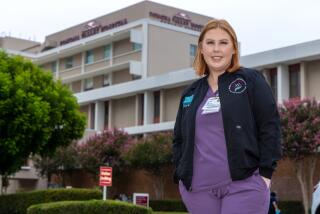Reliance on Nurses’ Assistants Grows
- Share via
As Cynthia Pepping stepped up to the bedside of 80-year-old heart patient Edward Kirby, she went through the time-honored rituals of nursing. She put him at ease, inquiring about his comfort, then took his temperature and blood pressure.
Clad in hospital scrubs, she looked just like a nurse. But she isn’t a nurse.
Pepping, 24, is an unlicensed hospital worker, one of a growing number who are doing bedside patient care once performed by registered nurses.
Unlicensed staffers such as Pepping can be found in just about any hospital in America. Unlike nurses, who must complete a required number of college-level courses and then pass a test to become licensed, these hospital workers do not require state licensing and there are no uniform standards.
Their training often lasts only two weeks. Their knowledge is considered so limited that they must work under the supervision of a registered nurse.
Last year, the number of unlicensed health care workers in the nation’s hospitals grew faster than the number of registered nurses, according to the American Hospital Assn.
Experts link the changing skill mix to cost containment policies under managed care.
One advantage for hospitals is that assistants such as Pepping earn less than half the amount paid to registered nurses. Using them also allows hospitals to free nurses for such things as monitoring patients’ conditions, planning discharges and dispensing medications.
“It’s an improvement, because we now have two people watching the patient and taking care of all their basic needs,” said registered nurse Gloria Ajo, Pepping’s supervisor at UCLA Medical Center.
But critics say the staffing changeover has become a matter of national concern because it is happening with few controls.
“In hospitals, we don’t have any across-the-board requirements for requiring and certifying that the nurse aides have been trained,” said Gooloo S. Wunderlich, who directed a 22-month study that looked into the changing skill mix in hospitals and whether it was affecting patient care. “You can hire anyone and give them a week’s training . . . a day’s training.”
The results of the study, directed by Wunderlich for the Institute of Medicine, part of the National Academy of Sciences based in Washington, D.C., were inconclusive. Researchers said they found little evidence that quality of care was suffering, but qualified that by saying they lacked adequate data to draw any definitive conclusions.
Researchers did determine that nurses’ assistants were assuming greater responsibilities and often were not trained to do such work.
At UCLA, the California Nurses Assn. has raised concerns that less skilled workers are being used as substitutes for registered nurses.
The care partner program began at UCLA three years ago with an initial class of 30. Today there are 120 care partners. During that same period, the medical center has eliminated the jobs of 60 registered nurses.
Pepping--backed up by supervisors--said she was hired to support registered nurses, not replace them.
“I only draw blood, I don’t give shots. I only take EKG readings, I don’t interpret them,” the hospital worker said during a break in the UCLA Medical Center’s fourth-floor medical observation unit.
Although Pepping is a college graduate with aspirations to go to medical school, UCLA requires only that its nurses’ assistants have a high school diploma and an emergency training certificate showing that they completed a basic medical training course. Pepping got her certificate by completing an intensified two-week training course through UCLA Extension. Once hired, she received additional training at the medical center.
But Pepping is an exception, say those who track hospital trends. The Institute of Medicine study said most hospitals in California hire minimally skilled nursing aides, and cited another study that said only 20% of the hospitals in the state even required a high school diploma.
Rosario Hurley, a nurses association activist who works as a floor nurse at UCLA, said she has worked with good and bad care partners.
“They get a few weeks training, then get put out on the floor,” she said. “They learn to measure vital signs, take blood pressure, check heart rate, but they don’t understand a patient’s physiology. With inexperienced ones, we have to check on everything they do.”
But Pepping said she undergoes constant training.
“I feel very comfortable with the job I am doing and the way I was trained. UCLA has put a lot of effort into making sure we know what we are doing,” she said.
More to Read
Sign up for Essential California
The most important California stories and recommendations in your inbox every morning.
You may occasionally receive promotional content from the Los Angeles Times.













